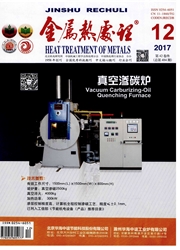

 中文摘要:
中文摘要:
利用场发射扫描电子显微镜观察了试验材料Fe-3.12%Si-0.11%Mn-0.021%S中MnS析出粒子在变形量为0%~68%的冷压缩加工过程中的分布状态,统计了MnS粒子的总面密度及不同尺寸范围粒子的面密度,分析了冷压缩加工过程中MnS粒子的变化规律。结果表明,冷变形过程造成了几十纳米尺寸MnS粒子的碎化和10 nm以下粒子的少量回溶行为;但未能造成尺寸过于粗大粒子的细化。分析认为,MnS粒子与基体的界面能和塑性变形造成位错密度的明显升高构成了细小粒子回溶的驱动力。MnS粒子在冷轧过程中的细化,有利于防止初次再结晶晶粒粗化,促进取向电工钢二次再结晶过程的顺利进行及锋锐Goss织构的生成。
 英文摘要:
英文摘要:
The distribution of precipitated MnS particles in Fe-3.12% Si-0. 11% Mn-0. 021% S experimental steel during 0%-68% cold reduction was observed by field emission scanning electron microscopy, while the area density of overall MnS particles and also area density of particles within different size range were statistically determined, then the evolution of MnS precipitate during the whole cold compressing process was analysed. The results show that the cold deformation procedure resulted in crushing of MnS particles with dozens nanometer size and small quantity dissolving of MnS whose diameter is below 10 nm, but not the crushing of particles that have extreme large size. Interface energy of MnS particle with matrix crystal and the increasing of dislocation density due to plastic deformation make up the driving force of fine particles' s dissolving process. The crushing of MnS precipitate during cold roll will help avoiding crystal coarsening during primary reerystallization, and prompting the formation of sharp Goss texture and helping secondary recrystallization to proceed smoothly in grain- oriented electrical steels.
 同期刊论文项目
同期刊论文项目
 同项目期刊论文
同项目期刊论文
 期刊信息
期刊信息
